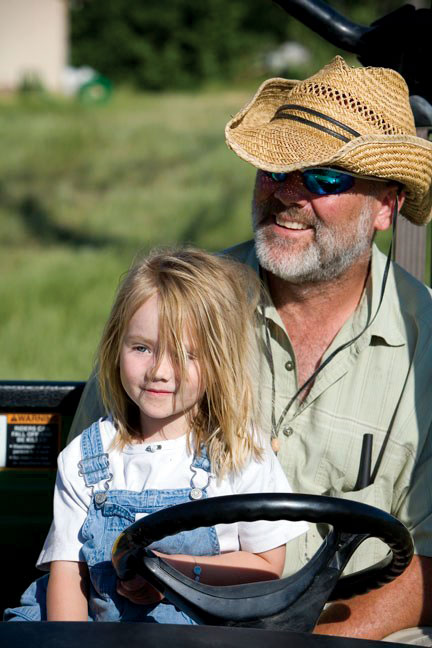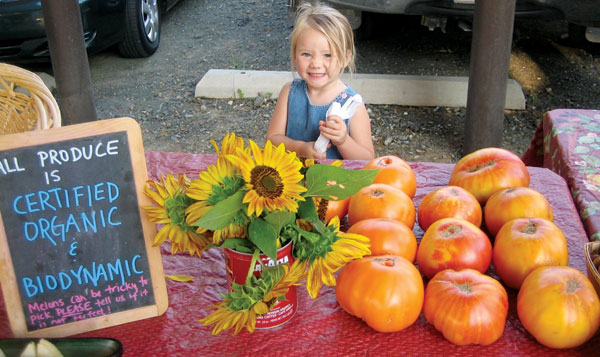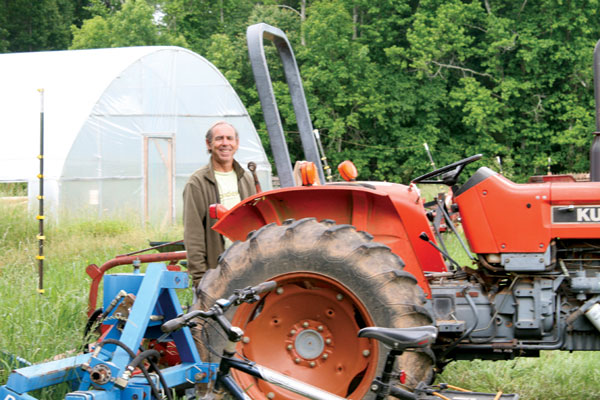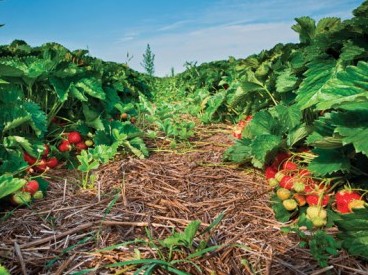The Organic Food Paradox
The terrain swoops and rises as I drive up North Carolina Route 86 toward the rural crossroads of Cedar Grove. By the time I reach Whitted Bowers Farm, it feels like the essence of American pastoral. I turn into the driveway on a December morning, passing trees that will soon be heavy with figs, plums, pears, and pomegranates. Goats nibble here and there. A large field looks tucked in for the winter, but underneath a woven blanket grow 20,000 strawberry plants. Further up stands an aluminum-frame greenhouse where globe artichokes have already begun their lives, bathed in classical music from a nearby boom box. I park in front of a modern farmhouse. Three dogs run up to greet me.
Rob and Cheri Bowers, who own this organic farm, welcome me with a mug of hot tea. Rob has spent the morning harvesting broccoli and Brussels sprouts from their cold-frame hoop house. When he and Cheri met in 2005—he’s 50; she’s 45—they were living in California and neither had ever farmed full-time. “Both of us were feeling a tremendous pull to walk around and get our feet dirty,” Rob tells me. They were surprised to discover a common fantasy of growing fruit through a sustainable method called biodynamics, which builds the fertility of the soil with limited use of imported materials. “Those are the kinds of coincidences that one needs to pay attention to,” he says. Within a year and a half, the couple was married with a six-month-old daughter and had found 52 acres blessed with good Carolina soil. Cheri had grown up near the site of their new home. Her mother and siblings lived six miles away.

“We literally put everything we had …” Rob begins—
“… energy, money, spiritually …” adds Cheri—
“… into this place,” Rob continues. “We really did want that experience of knowing what it meant to have a crop come in, and to feel what it meant to be reliant on what is basically a gift.”
If there was ever a time when consumer demand could support organic farmers like the Bowerses, that moment is now. Americans have grown savvy to the health and environmental benefits of foods produced without chemical fertilizers or pesticides. Organic food sales grew 7.7 percent in 2010 to $28.6 billion, more than ten times the growth rate for all food. Organics now command a 4 percent share of the total food market, up from 1.6 percent a decade ago. At my own farmer’s market in Durham, N.C., getting the best pickings means rising early and dodging the crowds. Likewise, community-supported agriculture (CSA)—in which customers get their food delivered straight from the farm—is flourishing. (To find a CSA near you, go to localharvest.org.)
Organic produce fills bins not only at self-consciously green megastores like Whole Foods, but also at traditional supermarkets and retailers like Wal-Mart. Health-conscious parents buy organic milk in cartons illustrated with cartoons of happy cows. There are organic wines, organic baby foods, organic pretzel bunnies. The Organic Trade Association, an industry group for North American producers and distributors, describes this explosion as a “cultural quickening.”
But along with this quickening come questions of what organic really means. Do strawberries from small farmers like the Bowerses fit under the same umbrella as the Surfin’ Strawberry yogurt tubes manufactured by Horizon Organics, a subsidiary of the $12-billion-a-year Dean Foods, the nation’s leading milk processor? How friendly to the environment are bagged salad greens shipped 8,000 miles from New Zealand or tomatoes grown in the Mexican desert? Are organic cookies healthy cookies? And in an era of industrial-scale production, can family farms in places like Cedar Grove survive?

In the beginning it was more of a movement than a market niche.
Steve Gilman, a farmer in Stillwater, N.Y., can trace his own start in organics to the Vietnam War era and the back-to-the-land movement of the 1960s and 70s. “There was a whole generation who had contact with a counter-cultural viewpoint,” he says. “It was a sane approach and a positive approach: Instead of being anti-war or anti-everything, it was being for something.” Organic farming embodied so many values of the era: community life, clean water and air, and the rejection of large, profit-driven industries like agrochemical companies.
Of course, farmers had been growing without synthetics since the dawn of agriculture. And decades before Baby Boomers like Gilman came along, modern organic techniques were being developed by pioneers such as Rudolph Steiner (who developed biodynamics) and the Rodale Institute. But growing anxiety about the planet’s well-being (think Rachael Carson’s 1962 wake-up call Silent Spring and the first Earth Day in 1970) helped set the tone for a more widespread embrace. So did news like the Alar scare of the 1980s in which the now-banned apple pesticide was linked to cancer.
In 1990 Congress tried to regulate the organic label by passing the Organic Foods Production Act. It took another dozen years—and fierce debates over issues such as genetic engineering and sewage-sludge fertilizer—before the U.S. Department of Agriculture (USDA) set the official standards. From 2000 through 2008 the sector went gangbusters: Organic food sales climbed 15 to 21 percent each year, and organic non-foods like cotton were posting annual growth rates upwards of 40 percent.

“This is where things started shifting,” says Gilman, policy coordinator for the Northeast Organic Farming Association Interstate Council. “A lot of corporations started to see that they better get something on board with organic. If you’re in any kind of business, you’ve got to have some skin in the game.”
Thus started the era of what author Samuel Fromartz calls “Organic Inc.” Kraft, Kellogg, Hershey, and ConAgra developed or acquired organic product lines. General Mills bought Cascadian Farm. Horizon Dairy, before its purchase by Dean Foods, took over an industrial-scale dairy in the Idaho desert to help supply some of the organic milk. Retail chains began selling organic processed foods: toaster waffles, frozen pizzas, and Oreo knockoffs. Large-scale vegetable growers, particularly in California, started claiming their portion of the fresh-produce market.
I talked with one of them: Jeff Huckaby, executive vice president of Grimmway Farms, the world’s largest carrot grower. In 1995, he told me, his company was concerned that tougher pesticide regulations would force it to shelve some of its most potent farm chemicals. So Grimmway set aside 300 acres for an organic experiment. “We found that, all right, we can do this,” he says. “It costs a lot more and the yield isn’t as good. But if they took every tool away today, we wouldn’t be out of business.” Anticipating the future, the company ramped up its non-chemical side and in 2001 bought a competitor called Cal-Organic.
“That’s when the organic movement took off, especially Whole Foods,” Huckaby says. “We happened to have the kind of acreage they needed to get larger volumes out to fill their stores.” Eventually, Grimmway put almost 30,000 of its 100,000 acres into organic production, spread over eight growing regions to assure year-round availability. It expanded its offerings to 70 vegetables. It attracted Costco and Wal-Mart as customers. “The larger retailers like the fact that they can come to one company and know what our growing practices were like, what our food-safety programs were like. And they knew that they could count on us—we probably would not run out. They were able to call us up and say, ‘Let’s figure out how to get Romaine lettuce 52 weeks a year,’ and we were able to supply that for them.”

Now, when you walk into a supermarket, the organic carrots you see are likely to come from Grimmway. The bagged organic salad greens will probably come from Earthbound Farms, which grows on nearly 37,000 acres in the U.S., Mexico, Peru, New Zealand, and six other countries.
“The grocery stores don’t want to be bothered with buying from tons of different companies. So that middle part of the supply chain is really concentrated,” says Carolyn Dmitri, a research associate professor of food studies at New York University. Organics are no different. “It’s almost like your success becomes your enemy. Once you’re popular and people want organic, the only way that it’s going to happen is if it blends into our existing food system.”
For some of organic’s boosters, this concentration is just fine. “Any acre converted from non-organic production to organic—even if it’s industrial—is a victory for the environment,” says Helge Hellberg, a California consultant who until 2011 directed a farmers’ association called Marin Organic. Hellberg used to be more of a purist. But he has come to believe that the highest virtue comes from getting synthetic pesticides and fertilizers off the landscape and out of our bodies as quickly as possible. “The greatest opening right now, in terms of numbers, is the school systems around the nation. It’s the Safeways, the Wal-Marts, and all the companies that add an organic line. The quantity these companies need—that will most likely not come from small-scale producers.”
It’s hard to argue against getting healthy food to more people or getting toxic chemicals out of the soil. Organic agriculture has the potential to be transformational—slowing down global warming and providing a more stable food source as extreme weather events such as floods and droughts increase. It will never achieve that potential if it remains the sole province of deep-pocketed foodies.
But the tradeoffs that come with Organic Inc. can’t be papered over. The biggest, perhaps, is the betrayal of the original intent of the movement. “Part of why many of us went to organic many, many decades ago was because of the kind of concentration and difficulty we saw in the agribusiness-as-usual model,” says Michael Sligh, the founding chair of the National Organic Standards Board (NOSB), which advises the USDA. “Some of that has come to organic.” The big-business model puts more emphasis on efficiency—and less on local production, animal welfare, and long-term sustainability. In December The New York Times published an article about organic tomatoes grown in Mexico’s arid Baja Peninsula, a practice that guarantees year-round availability in the U.S. but also depletes the desert’s scarce water.

What’s more, some large organic animal operations look strikingly like the factory farms they were supposed to supplant. The Cornucopia Institute, a Wisconsin-based advocacy group for family farmers, recently investigated the organic egg industry and discovered aviaries housing up to 85,000 hens, “wall-to-wall, floor to ceiling,” with minimal or no access to pasture. “How can that be,” asks Mark Kastel, Cornucopia’s co-founder, “when the law clearly states that all organic livestock must be able to exhibit their natural instinctive behaviors and have access to the outdoors?” Last year, the USDA started requiring better outdoor access for organic cattle. It’s considering the same for poultry, though the proposed minimum standard for laying hens would be less than one-twentieth of the space the European Union mandates.
And the status quo remains slippery thanks to the industry’s political power. “The lawyers and lobbyists for big ag are in D.C. every day, influencing the regulators,” says former NOSB chair Jim Riddle, organic outreach coordinator for the University of Minnesota’s Southwest Research and Outreach Center. For example, the USDA keeps a list of non-organic ingredients that can legally be used in organic food processing. Originally it was designed for such basics as baking powder. But the list has grown lengthy, and there’s constant pressure to add more exceptions. Sometimes industry loses—as when the USDA rejected a request to allow a large bakery to spray their organic English muffins with an anti-fungal preservative. But not always. For example, organic breweries successfully petitioned the government to allow them to use hops treated with synthetic pesticides. (The USDA plans to lift that exemption in 2013.) Sausage makers can use casings made from the intestines of animals raised with hormones and antibiotics. “All kinds of things have been allowed that don’t seem to me to fit anything organic,” says former NOSB member Joan Gussow, a professor emeritus of nutrition and education at Columbia University. “This small hole that was made for things that seem acceptable has been gone through by all kinds of materials.”
The danger lies in devaluing the organic label, says Sligh, who is also a director of Rural Advancement Foundation International. “We have to be exceedingly careful,” he says, “that we don’t end up undermining the golden goose by this pressure to ever create more and more sophisticated processed foods.”

Not surprisingly, Organic Inc.’s growth has also touched family farmers. Some have seen their traditional sources of income dry up as their commercial clients turn to larger suppliers. I talked with Ray Christopher, who runs Timberwood Organics, a 12-acre farm in Efland, N.C. Until a decade ago one of his most reliable customers was a nearby Whole Foods Market whose buyer assured Christopher that his vegetables flew off the shelves. But then “it got back to corporate that she was buying from me at a high price, and they could have been making a lot more money if they were buying from California,” he says. “Because of the bottom line, it got canned.”
I heard several stories like this. “We used to have a robust restaurant business,” says Tom Philpott, co-founder of the non-profit Maverick Farms in Valle Crucis, N.C. Philpott started the educational farm—which uses organic methods but (like many small growers) is not USDA-certified—in 2004. “A couple of years in we started getting feedback from restaurants: ‘Look, we can get organic baby greens shipped in from California for cheaper.’” One national distributor promised to shave 20 to 30 percent off Maverick’s best price. So the local farm stopped supplying restaurants. “We’re not interested in taking on that type of competition,” says Philpott, who blogs about food for Mother Jones magazine.
The good news is that small farms are nimble. Timberwood and Maverick have ramped up their community-supported agriculture programs and command decent prices by delivering fresh produce to customers. Both sell at farmers markets too. This is how organic family farms will survive: by bypassing long supply chains and dealing instead with the people who eat their food. “It’s a personal relationship: ‘If you buy from me, I’ll be here tomorrow. I’ll be here next year. I’ll respond to your needs. We’re in this together,’” says Minnesota’s Jim Riddle.
That intimacy is precisely what has kept Rob and Cheri Bowers afloat since they moved to Cedar Grove, N.C., in 2006. Their biodynamic growing method goes beyond mainstream organics. They rely heavily on compost and do intensive soil preparation using herbs, seaweed, fungi, worm castings, and manure to “create a living fertility in the soil,” Rob says. They limit even organic fertilizers brought in from the outside. They use cover crops intensively. And they orient their work by lunar and astral cycles—in order, they say, to take advantage of phenomena like the moon’s gravitational pull on the Earth’s water.
The Bowerses started by selling to a wholesale distributor, which in turn sold their produce to Whole Foods. “We didn’t like how that felt,” Cheri says. Nor did they like the price markup they saw at the supermarket. After a year, they pulled back, and now they sell at a farmers market and to nearby restaurants. During the spring, they open their strawberry fields as a U-Pick operation. By eliminating the middlemen, Rob and Cheri say they have kept their prices competitive with (and occasionally lower than) conventional produce sold at supermarkets. Even when they do charge more, customers remain loyal. Rob tells me about one weekend during the 2011 strawberry season when Whole Foods ran a sale on non-local fruit that undercut his price by almost two-thirds. “Ironically, that was a record weekend for us,” he says.
Part of their success stems from the quality of their food. The Bowerses sent me home with a bag filled with speckled-trout lettuce, baby Romaine, and two types of bok choy. Not only was it super-fresh, but the flavors were extraordinarily complex. “We’ve had people come to the market and say: I don’t know what it is about your stuff, but it feels alive,” Rob says. But there’s also something less tangible. “In this country everybody’s disconnected with their food. Their relationship is more through packaging and marketing.” But when people pick their own organic strawberries, that relationship changes. “It reconnects people in a way that they need.”
It will take more than U-Pick strawberry operations for organic farming to radically improve our planet’s health. But as we re-imagine agriculture, one would hope small farms like the Bowerses’ remain a vital part of the mix. The money they earn stays in the community. The farmers markets where they sell their produce bring neighbors together. They provide the story behind our food, filling a primal human need. And in a country that is becoming ever more urban, they serve as stewards of a diminishing treasure.
“One of the most incredible blessings is just to be able to become intimate with a piece of land over the course of a year and to see every day how it changes,” says Rob. “I always joke with Cheri: ‘We’re not farming this land. It’s farming us.’”
